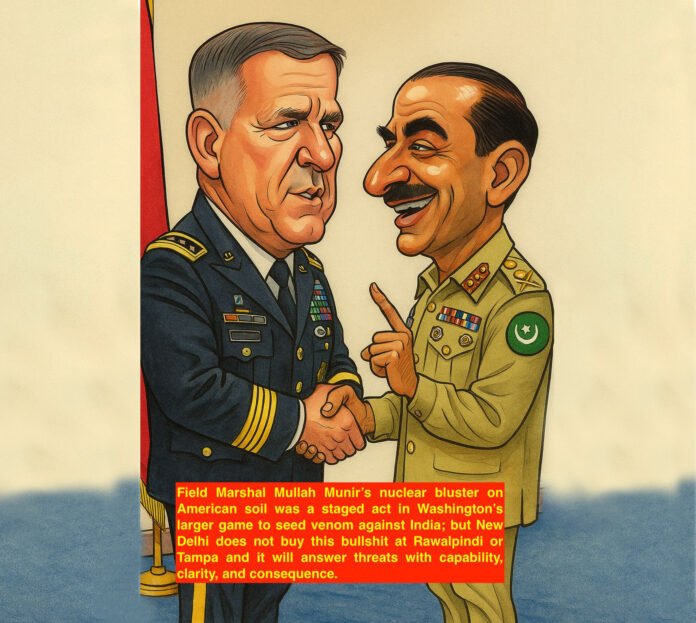The dinner in Tampa should have been a ceremonial evening, a polite gathering of diaspora members, dignitaries, and military leaders. Instead, it became a platform for one of the most explicit nuclear threats ever issued by a Pakistani leader, delivered not in Islamabad or Rawalpindi but on the American soil. Field Marshal Asim Munir, Pakistan’s army chief, told his audience that if his nation ever faces an existential threat in any future war with India, it would take half the world down with it.
This was not the common sabre rattling across the border. It was a well-calculated, scripted speech, uttered in front of American military officials and the Pakistani diaspora, and delivered in the iconography of theology and historical allusions, and overt aggressiveness toward India. In both content and setting, it was a message meant to resonate well beyond the ballroom in Florida.
The Calculated Shock Value
Nuclear posturing has long been a fixture in South Asian regional politics. Both India and Pakistan have wielded the implicit threat of mutual destruction, since they declared themselves as nuclear powers. Munir’s words were unusual in two ways. They were delivered in the United States, a country that claims to champion nuclear restraint in the region, and they were unambiguously personal and theatrical.
FM Asim Munir’s speech in the US was not just a common sabre rattling across the border. It was a well-calculated, scripted speech, uttered in front of American military officials and the Pakistani diaspora, and delivered in the iconography of theology and historical allusions, and overt aggressiveness toward India. In both content and setting, it was a message meant to resonate well beyond the ballroom in Florida
Choosing to speak in America was deliberate. It positioned Pakistan’s military chief as a global player, using a high-profile foreign visit for brinkmanship rather than quiet diplomacy. It also placed Washington in an awkward position. Almost immediately, a US military spokesperson described America’s partnership with Pakistan as necessary for advancing shared security goals and for nuclear security in South Asia. The contrast was striking. On one hand, a nuclear threat. On the other hand, an endorsement.
The Indus Waters Card
Munir extended his warnings to water security, too. He attacked India’s decision to suspend the Indus Waters Treaty, after the April 2025 Pahalgam terror attack, declaring that Pakistan would destroy any infrastructure India built on the Indus or its tributaries. His words were blunt. Pakistan would wait for India to build a dam and then destroy it with ten missiles.
The Indus Waters Treaty has endured wars and decades of political hostility. For Pakistan’s top soldier to openly threaten its destruction is to turn water into a potential trigger for a military conflict. In a climate-stressed region such as South Asia, such threats move disputes from the realm of policy into the realm of war planning.
Religion as Justification
Much of Munir’s address leaned on religious imagery. Quranic verses were invoked to link divine sanction with military action. He compared Pakistan to Madinah, claiming both were founded on faith and destined for divine reward in the form of natural resources and strategic advantage. This was not merely rhetoric for the diaspora. It was also a statement to Pakistan’s domestic audience, reinforcing the idea of divine purpose behind its national policies.
Much of Munir’s address leaned on religious imagery. Quranic verses were invoked to link divine sanction with military action. He compared Pakistan to Madinah, claiming both were founded on faith and destined for divine reward in the form of natural resources and strategic advantage. This was not merely rhetoric for the diaspora. It was also a statement to Pakistan’s domestic audience, reinforcing the idea of divine purpose behind its national policies
For a Western audience, the interweaving of theology and nuclear threats sends a dangerous signal. It blurs the line between strategic deterrence and ideological conviction. When nuclear policy becomes infused with belief systems, it increases unpredictability in crises.
The Dump Truck Analogy
Munir likened India to a shining Mercedes and Pakistan to a dump-truck full of gravel. His point was that if the truck hit the Mercedes, both would lose, but the implication was that Pakistan’s leverage lies in its capacity to cause catastrophic damage at a lesser cost, despite its economic and technological disadvantage.
The analogy exposes the core of Pakistan’s deterrence strategy. Accepting conventional weakness, it seeks to offset it with nuclear capability and asymmetric tactics. That is why nuclear rhetoric is used so liberally, even at non-military forums.
US Favour and India-US Strain
Munir’s cordial meetings with American military officials, his private discussions with political and defence top brass, and his White House luncheon with President Trump point to a warming of the US-Pakistan ties. Meanwhile, India faces 50 per cent tariffs on its goods and criticisms over Russian defence imports. In contrast, Pakistan enjoys lower tariffs and renewed military cooperation from the US.
In New Delhi, this divergence will cause concern. India has invested in a strategic partnership with the United States, particularly in the Indo-Pacific. If Washington panders Pakistan, despite open nuclear threats, Indian policymakers will question the depth of the Indo-US alignment.
Munir’s remarks could be exploited politically. The suggestion that his words were encouraged or shaped, hints at a possibility. Washington might use this crisis narrative to revive mediation offers on Kashmir and the Indus Waters Treaty. Trump has shown a taste for presenting himself as a South Asia dealmaker. A nuclear flashpoint storyline plays directly to encourage that ambition
The Shadow of Operation Sindoor
Operation Sindoor remains fresh in everyone’s memory. In just four days of precision strikes, India targeted terrorist bases inside Pakistan and Pakistan-occupied territory following the Pahalgam attack. It proved that India could act decisively without being paralysed by Pakistan’s nuclear posturing.
For Pakistan’s military, the operation was a reminder that deterrence can fail. Munir’s rhetoric in Tampa may have been an attempt to restore a sense of psychological balance after that setback.
The Trump Factor
Munir’s remarks could be exploited politically. The suggestion that his words were encouraged or shaped, hints at a possibility. Washington might use this crisis narrative to revive mediation offers on Kashmir and the Indus Waters Treaty. Trump has shown a taste for presenting himself as a South Asia dealmaker. A nuclear flashpoint storyline plays directly to encourage that ambition.
India’s Path Forward
India’s stance is clear. Cross-border terrorism will be met with targeted retaliation. Nuclear threats will not deter such responses. The model of political and military cohesion, seen during Operation Sindoor will continue to guide future actions.
However, India must strengthen its international narrative. The speech that Munir gave in the United States is an indicator that the cognitive warfare and battle of narratives are being unleashed. Pakistan has had a long-standing history of developing sympathetic networks toward other countries, to reinforce its narrative. India will need to be equally assertive in global opinion shaping, diplomatically.
For India, the response must combine readiness for immediate action with a sustained global influence strategy. Pakistan has experienced and honed the importance and use of narrative as a stratagem. In the world, perception shapes reality. India needs to put up an equal effort in the area of cognitive warfare. It needs to win both in the geographical battlespace and the cognitive geometry space
The Larger Risk
The real danger is not that Pakistan would unleash a nuclear strike capable of destroying half-the-world. That would be suicidal for its own existence, too. The danger lies in normalising such threats. Repeated unchecked statements lower the psychological threshold for escalation.
Triggering the nuclear threats in relation to water rivalry, introduces another element of instability. With increasing water scarcity, these threats also have an increased risk of tipping over into outright conflict. India is prepared, and Op Sindoor has not ended yet.
Bluff or Warning
Is Munir bluffing for theatrical effect or signalling a genuine shift in Pakistan’s doctrine? The answer might be a mix of both. Bluff or not, making such statements in a foreign capital with apparent diplomatic indulgence has consequences.
For India, the response must combine readiness for immediate action with a sustained global influence strategy. Pakistan has experienced and honed the importance and use of narrative as a stratagem. In the world, perception shapes reality. India needs to put up an equal effort in the area of cognitive warfare. It needs to win both in the geographical battlespace and the cognitive geometry space.
The author, a PVSM, AVSM, VSM has had an illustrious career spanning nearly four decades. A distinguished Armoured Corps officer, he has served in various prestigious staff and command appointments including Commander Independent Armoured Brigade, ADG PP, GOC Armoured Division and GOC Strike 1. The officer retired as DG Mechanised Forces in December 2017 during which he was the architect to initiate process for reintroduction of Light Tank and Chairman on the study on C5ISR for Indian Army. Subsequently he was Consultant MoD/OFB from 2018 to 2020. He is also a reputed defence analyst, a motivational speaker and prolific writer on matters of military, defence technology and national security. The views expressed are personal and do not necessarily carry the views of Raksha Anirveda






